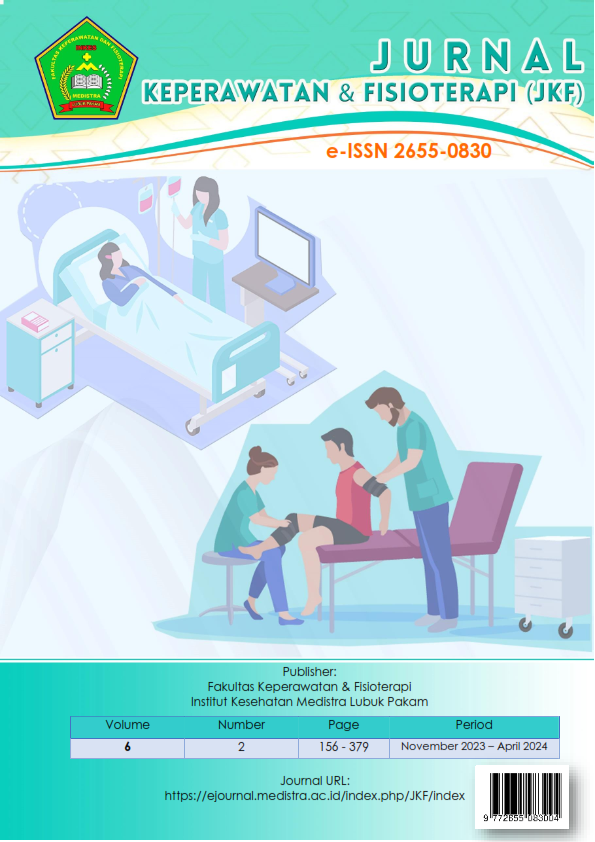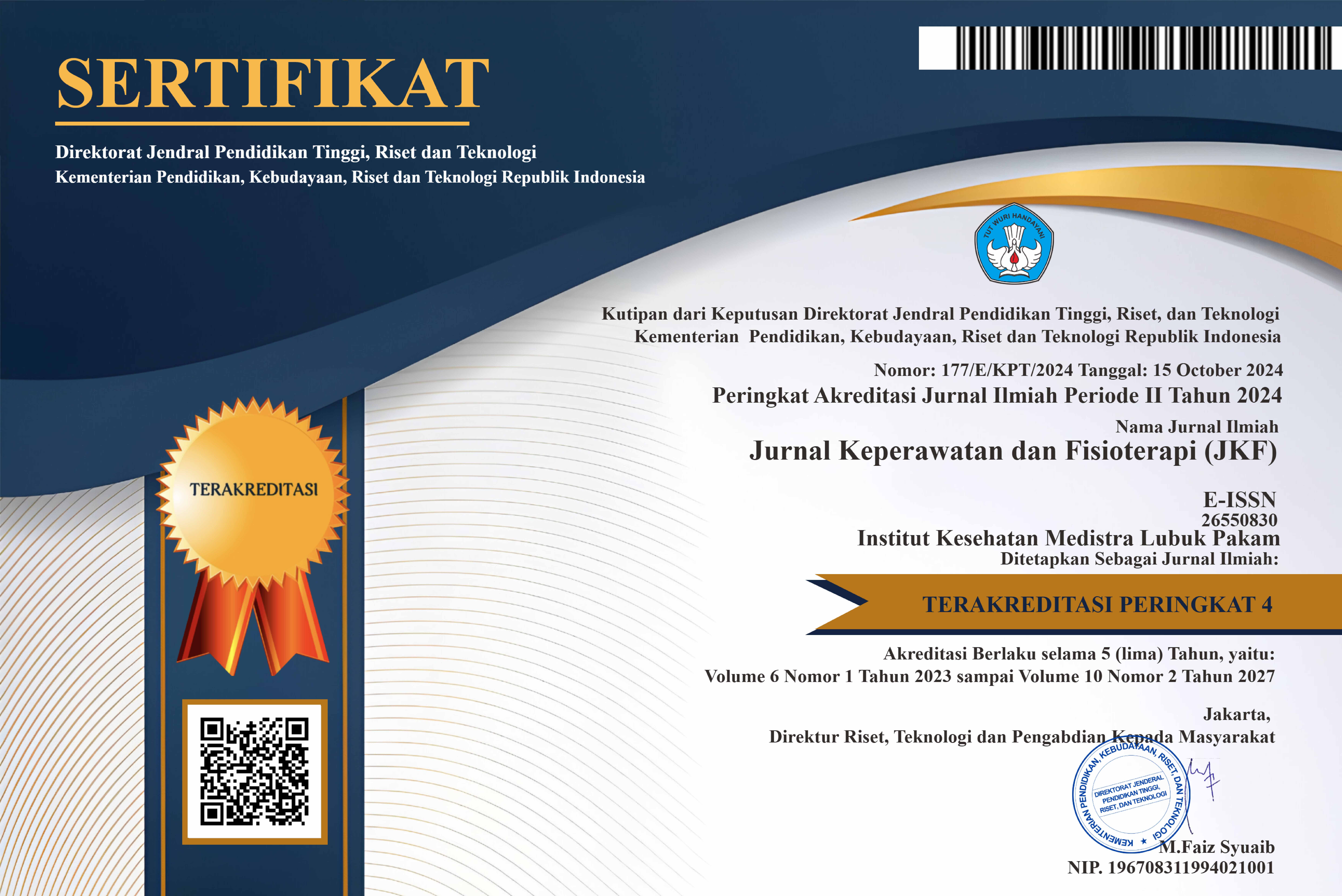The Analysis of the Speed and Effectiveness of Resuscitation Actions in Patients with Cardiac Arrest in the Emergency Department
Analysis of the Speed and Effectiveness of Resuscitation Actions in Patients with Cardiac Arrest in the Emergency Department
DOI:
https://doi.org/10.35451/jkf.v6i2.2545Keywords:
Resuscitation, cardiac arrest, ROSCAbstract
Cardiac arrest is a medical emergency requiring rapid and effective resuscitation to improve patient survival. The speed of resuscitation has been linked to the success of return of spontaneous circulation (ROSC); however, delays are still common in many healthcare facilities. This study employed a quantitative method with a retrospective observational analytic design. Data were collected from medical records of cardiac arrest patients in the Emergency Department (ED) over the past year. Univariate analysis was conducted to describe patient characteristics, while bivariate analysis using the Chi-Square test and multivariate analysis using logistic regression were performed to examine the relationship between resuscitation speed and ROSC outcomes. Among the 60 patients analyzed, 58.3% were over 50 years old, and 66.7% were male. The Chi-Square test showed a significant relationship between resuscitation speed and ROSC success (p = 0.03). Logistic regression analysis indicated that patients who received resuscitation within less than 2 minutes had 2.5 times higher odds of achieving ROSC compared to those who received delayed resuscitation (p = 0.02). This study aligns with the American Heart Association guidelines and previous research, highlighting that the speed of resuscitation significantly influences patient recovery. Therefore, improving medical staff readiness and optimizing emergency response systems in EDs are crucial to enhancing the quality of cardiac arrest management.
Downloads
References
American Heart Association. (2020). Guidelines for Cardiopulmonary Resuscitation and Emergency Cardiovascular Care. Circulation, 142(16_suppl_2), S337-S357. https://doi.org/10.1161/CIR.0000000000000911
Andersen, L. W., Holmberg, M. J., Berg, K. M., Donnino, M. W., & Granfeldt, A. (2018). In-hospital cardiac arrest: A review. JAMA, 319(12), 1236-1249. https://doi.org/10.1001/jama.2018.4149
Girotra, S., Nallamothu, B. K., Spertus, J. A., Li, Y., & Chan, P. S. (2017). Trends in survival after in-hospital cardiac arrest. New England Journal of Medicine, 367(20), 1912-1920. https://doi.org/10.1056/NEJMoa1109148
Kementerian Kesehatan Republik Indonesia. (2022). Laporan Data Penyakit Kardiovaskular di Indonesia. Pusat Data dan Informasi Kemenkes RI. Retrieved from https://sehatnegeriku.kemkes.go.id
Kitamura, T., Iwami, T., Kawamura, T., Nagao, K., Tanaka, H., Nadkarni, V. M., & Hiraide, A. (2020). Conventional and chest-compression-only cardiopulmonary resuscitation by bystanders for children who have out-of-hospital cardiac arrests: A prospective, nationwide, population-based cohort study. The Lancet, 375(9723), 1347-1354. https://doi.org/10.1016/S0140-6736(10)60064-5
Meaney, P. A., Bobrow, B. J., Mancini, M. E., Christenson, J., de Caen, A. R., Bhanji, F., ... & Edelson, D. P. (2013). Cardiopulmonary resuscitation quality: Improving cardiac resuscitation outcomes both inside and outside the hospital. Circulation, 128(4), 417-435. https://doi.org/10.1161/CIR.0b013e31829d8654
Perkins, G. D., Graesner, J. T., Semeraro, F., Olasveengen, T., Soar, J., Lott, C., ... & Monsieurs, K. G. (2019). European Resuscitation Council Guidelines 2019: Resuscitation and supporting life in adults. Resuscitation, 144, 1-12. https://doi.org/10.1016/j.resuscitation.2019.08.021
Sawyer, T., Umoren, R., Gray, M. M., & Szyld, D. (2020). Advances in simulation-based training and assessment for neonatal resuscitation. NeoReviews, 21(1), e1-e12. https://doi.org/10.1542/neo.21-1-e1
Wang, H. E., Prince, D. K., Drennan, I. R., Vaillancourt, C., Morrison, L. J., & Aufderheide, T. P. (2021). Post-resuscitation care and survival outcomes after out-of-hospital cardiac arrest. Circulation, 143(13), 1335-1350. https://doi.org/10.1161/CIRCULATIONAHA.120.048112
World Health Organization. (2021). Cardiovascular diseases (CVDs). Retrieved from https://www.who.int/news-room/fact-sheets/detail/cardiovascular-diseases-(cvds)
Nichol, G., Thomas, E., Callaway, C. W., Hedges, J., Powell, J. L., Aufderheide, T. P., ... & Rea, T. D. (2008). Regional variation in out-of-hospital cardiac arrest incidence and outcome. JAMA, 300(12), 1423-1431. https://doi.org/10.1001/jama.300.12.1423
McNally, B., Robb, R., Mehta, M., Vellano, K., Valderrama, A. L., Yoon, P. W., ... & Centers for Disease Control and Prevention. (2011). Out-of-hospital cardiac arrest surveillance—Cardiac Arrest Registry to Enhance Survival (CARES), United States, October 1, 2005–December 31, 2010. Morbidity and Mortality Weekly Report: Surveillance Summaries, 60(8), 1-19. https://www.cdc.gov/mmwr/preview/mmwrhtml/ss6008a1.htm
Chan, P. S., Krumholz, H. M., Nichol, G., & Nallamothu, B. K. (2008). Delayed time to defibrillation after in-hospital cardiac arrest. New England Journal of Medicine, 358(1), 9-17. https://doi.org/10.1056/NEJMoa0706467
Morrison, L. J., Neumar, R. W., Zimmerman, J. L., Link, M. S., Newby, L. K., McMullan, P. W., ... & Ornato, J. P. (2013). Strategies for improving survival after in-hospital cardiac arrest in the United States: 2013 consensus recommendations. Circulation, 127(14), 1538-1563. https://doi.org/10.1161/CIR.0b013e31828b2770
Holmberg, M. J., Ross, C. E., Fitzmaurice, G. M., Chan, P. S., Duval-Arnould, J., Grossestreuer, A. V., ... & Andersen, L. W. (2019). Annual incidence of adult and pediatric in-hospital cardiac arrest in the United States. Circulation, 139(10), 1227-1237. https://doi.org/10.1161/CIRCULATIONAHA.118.038718
Downloads
Published
Issue
Section
License
Copyright (c) 2024 Suryani

This work is licensed under a Creative Commons Attribution 4.0 International License.
Copyright in each article is the property of the Author.


























